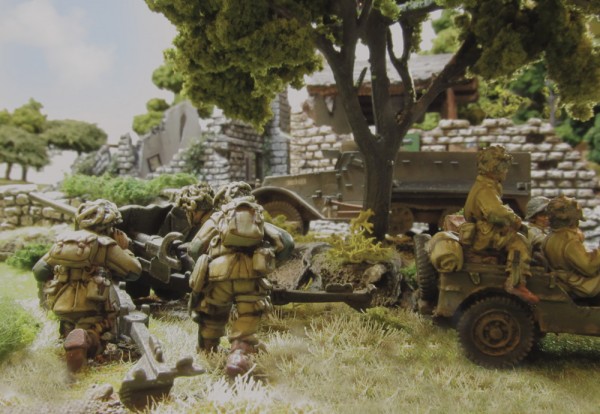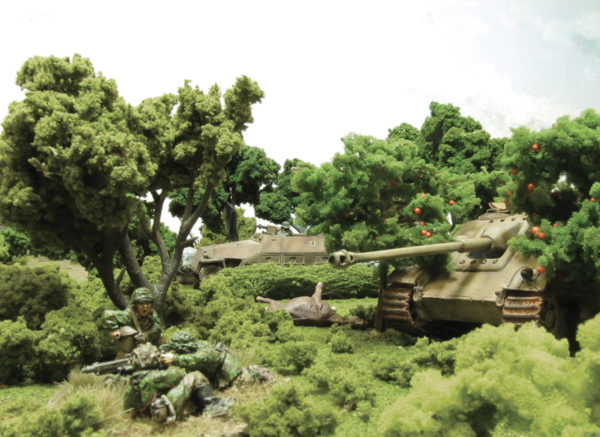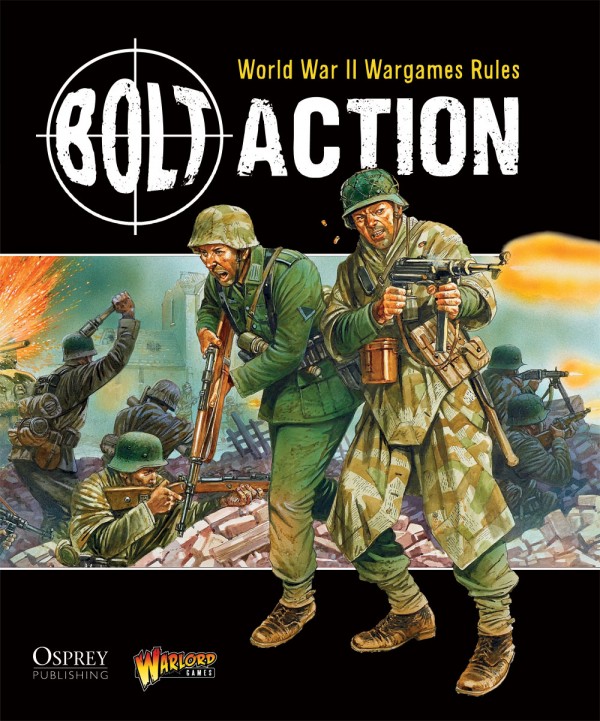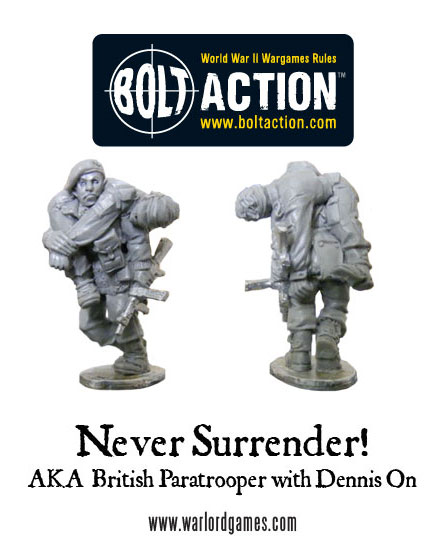Genial entrada ,del mítico Rick Priestley, hablando sobre el tamaño de los ejercitos en Bolt Action, el juego de la segunda guerra mundial, creado junto al legendario Alessio Cavatore.
Rick Priestley nos habla de por que no considera el Bolt Action un juego
de escaramuzas , de las posibilidades de tamaño de ejercitos y de como
se organizan. Entrada muy interesante.. La traduciré a lo largo del día
de hoy.
Although I write this before the official launch of the new Bolt Action game, a few advance copies have already found their way into the world, and I have noticed one or two short reviews elsewhere on the internet. Although these reviews are obviously based on a quick read through rather than play – for the moment at least – it is interesting to read these initial comments about the game. One thing that does seem to come up amongst the internet tittle-tattle is the size of the game – which some people describe as ‘skirmish’ whilst others plainly regard it as a ‘battle’ game. This is – of course – nothing but bickering over semantics – as what one person thinks of as a ‘skirmish’ kind of wargame another might consider a ‘platoon’ or ‘company’ action, or merely as a ‘small’ game.
Bolt Action is actually designed to play a wargame on a standard-sized table with sufficient 28mm models to make an entertaining game without undue crowding and without vast acres of tabletop going unused. When I say standard-sized table I mean 6 by 4 feet – as that is the sort of size most people have access to – and that is the size all of the scenarios are pitched at. Of course, we have made the game easily expandable, so it plays well with larger forces and on bigger tables – but we didn’t want to create a game where you needed hundreds of models, dozens of tanks, and tables twenty foot long and ten feet wide to play. You can play those kind of games with Bolt Action – indeed we have played those kind of games with Bolt Action – but we wanted a game that was playable within a reasonable time frame using a modest force that could be put together by a new player fairly quickly.
Myself – I wouldn’t call Bolt Action a skirmish game, because I think of a skirmish wargame as the sort of affair where every man is named and has unique characteristics, where a bullet graze might nick a man’s ear, where ammunition has to be accounted for, guns reloaded, and the game broken down into segments tiny enough to limit individual actions to speaking a few words, taking a step of two, or aiming a shot. That sort of game is fine if you’re using – say – a dozen models a side – or playing a first-person shooter on a computer. Bolt Action isn’t about individual men – it’s about squads of troops supported by heavy weapons, transport vehicles, tanks, artillery and air strikes. My own inclination is to think of this kind of game as a company or platoon action – but it’s all semantics at the end of the day and you can call it what you like.
The Bolt Action game has army lists and points values – and these define the numbers and types of units available for a force – though there is no need to use them if you do not wish to do so, of course. We do not always do so – often preferring instead to match a force to a scenario we have invented. For those who do wish to use the army lists and points values, the forces are built on 1,000 requisition points as a ‘standard’ building block. This gives a modest-sized force and is easily enough to get started. Where larger forces are required, add more blocks! Here is a typical 1,000 point British force selected from the army list given in the book.
click image for larger view
Platoon 1
Platoon Commander – Regular Second Lieutenant 50pts
Artillery Observer – Regular Artillery Forward Observer – Free
Number 1 Section – Regular 10 men including Bren gunner and NCO armed with SMG – 123 points
Number 2 Section – Regular 10 men including Bren gunner and NCO armed with SMG – 123 points
Platoon Support
Vickers machine gun – Regular MMG team of 3 men – 50 points
PIAT –Regular PIAT team of 2men – 40 points
2” Mortar – Regular light mortar team of 2 men – 35 points
QF 6-pdr Anti-tank gun – Regular medium anti-tank gun and 3 crew – 75 points
Sherman Tank – Regular Sherman medium tank with 75mm gun – 195 points
Cost of number 1 platoon including support 691 points
Platoon 2 – Royal Marine Commandos
Platoon Commander – Veteran second Lieutenant 65pts
Number 1 Section – Veteran 5 men, 4 armed with SMGs and 1 with Bren gun– 97 points
Number 2 Section – Veteran 5, 1 armed with rifle, 3 armed with SMGs and 1 with Bren gun – 94 points.
Platoon Support
PIAT – Veteran PIAT team of 2 men – 52 points
Cost of number 2 platoon including support 308points
Total Cost of Force – 999 pts
In this case I’ve gone for two platoons – one of regulars and one of veteran Commandos. Every platoon has to include an officer and a minimum of two sections of at least five men each (and up to ten). As you can see I’ve gone for full-sized sections of regulars and smaller sections of veterans as these are expensive. Overall I have four good infantry units comprising 30 men plus two officers. The British get a Forward Artillery Observer for free (hurrah) and I could have added a Medic too – but decided to spend my points elsewhere. The first platoon enjoys the support of a selection of heavy weapons including a PIAT and 6pdr to give it some anti-tank capability. Its main punch is the Sherman – a 75mm gun tank. A far more formidable choice would be the 17pdr armed Firefly, but at 305 points this would have pretty much limited me to a single platoon, so I opted for the lighter gun with its superior HE capability. I’ve added the second platoon with its additional PIAT to create a small but potent strike force. Overall this selection will provide me with 13 units – a fair sized force that would put up a good fight against a similar-sized force of Germans.
The unit selection works like this…
You begin with a platoon – which has to include an officer to lead it and two infantry squads (’sections’ in the case of the British – an important thing to remember around these parts!) of at least 5 men each. That is the core ‘obligatory’ part of the platoon (a minimum of 11 men). These troops can be inexperienced, regular or veteran – points values varying accordingly. They come with rifles and can be given alternative armament such as light machine guns (LMG), sub-machine guns (SMG) and additional weapons such as anti-tank grenades – all at extra cost.
To flesh out the platoon you can give it ‘support’ in the form of additional units. Support can include up to 3 more infantry squads and up to 1 each of any of the following: a senior officer, medic, forward observer, machine gun, mortar, sniper, flamethrower, anti-tank team, artillery piece or anti-tank gun, an armoured car, a tank or comparable vehicle (such as a self-propelled or assault gun). The platoon can also include transport vehicles sufficient to carry or tow units as required. For example: if you have four infantry squads you can have four trucks or four armoured carriers to transport them – though these all cost extra points.
A force – whatever its total requisition points – can have any number of platoons although obviously this will be restricted somewhat by the points available. With only 1,000 points to spend resources are pretty tight, and you will probably have one or at the most two platoons. With 2,000 points or more you might opt for three or four platoons. Each platoon gives access to support, so the more points are available the easier it becomes to afford the bigger and more expensive types of kit – such as tanks and heavy anti-tank guns. In practice 2,000 points doesn’t tend to give twice as many units as 1,000, and 3,000 doesn’t equate to three times as much – because players will usually choose to take more or better tanks, heavier artillery, and so on. If you want to field whole formations of tanks (and many will) then you just need to increase the points value to allow for that – though you might also need a bigger table to fit them on!
Overall, the proportion of infantry to support, and especially to heavy weapons and tanks, is intended to give a mixed, balanced force capable of fulfilling the scenarios described in the Bolt Action book and of facing other forces chosen in the same way. Many of the scenarios rely on infantry to take and hold positions, so a good mix of troops is always a good idea. 1,000 points will give you a small basic force with a reasonable mix of troops, and therefore it’s a good basis to begin learning the rules. 1,000 points would also be the ideal size to play a game within an hour or two – the sort of time likely to be available in tournaments where games have to be fitted into a strict timetable. Players who already have substantial collections of models might want to pitch in at 2,000 or more points and throw whole squadrons of tanks, mobile artillery and assault guns onto the table – as we often do when we have a whole day or more to spend and a bunch of players to move things along.
For those of you who have yet to place an order for the Bolt Action rulebook you can do so here! In addition to the rulebook we’ll also send a fantastic exclusive FREE miniature depicting a British Paratrooper carrying a wounded comrade. We expect pre-orders to be sent out the week of the 20th September and you’ll also be receiving your free ‘Never Surrender!’ miniature as part of your pre-order.
Next week Rick will take a look at the role of morale in Bolt Action…







No hay comentarios:
Publicar un comentario